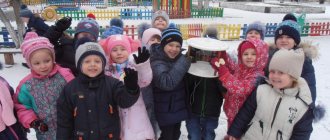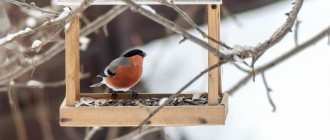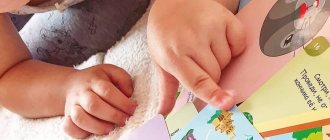Didactic games for older preschoolers 5-7 years old. Topic: Wintering birds
Didactic games for children of the senior preparatory group of kindergarten on the topic “Wintering birds”
Author: Pavlova Vera Valerievna, teacher of the special group of the Municipal Educational Institution "Bendery Kindergarten No. 9", Bendery Abstract: I offer a variety of didactic games and exercises for the formation of cognitive interest and speech activity, attention and logical thinking on the lexical topic "Wintering Birds", which are intended for educators and parents. Purpose: the proposed material will be useful in the implementation of educational activities, in joint and independent children's activities. Age audience: children of senior preschool age (5-7 years) Goal: formation of cognitive and speech activity of children by including a variety of games and exercises on the topic “Wintering birds” Objectives: - clarify and systematize children’s knowledge about wintering birds of the region (Moldova); -expand your vocabulary by forming complex words and consolidate the agreement of nouns with numerals; -develop memory and thinking, develop the ability to give reasons for your answers; - consolidate knowledge of proverbs and sayings about wintering birds. Didactic game “Guess what kind of bird, according to words and descriptions” Purpose: to consolidate the characteristics of wintering birds, to develop the ability to form complex words (red-breasted, long-tailed, etc.). Progress of the game: The teacher helps the children look at pictures of birds and says that he will name four words that suit this wintering bird.
Pupils listen carefully to the words and show a picture of a wintering bird. Then one child explains the answer. If the answer is correct, you can reward the child with a chip. Second version of the game: when consolidating the material, you can invite the children themselves to be the presenters and make wishes for wintering birds one by one. Didactic game “Recognize a bird by body parts” Goal: recognizing the external appearance of wintering birds of the region and developing speech skills to justify your answer. Progress of the game: The teacher shows the children a picture of nine birds, which are partially hidden under snowflakes.
Children guess the birds and explain their answers. If you give a correct, reasoned answer, you can reward your child with a chip. Explanations for teachers: In Moldova, wintering birds include: mute swan; nuthatch; sparrow; Great Grebe; hawk; magpie; gray and white heron; tit; mallard ducks; bullfinch and others. Didactic game “Lay out wintering birds according to the pattern” Goal: correlating wintering birds and geometric shapes, laying out a chain of four birds using modeling technology Progress of the game: The teacher shows large cards on which wintering birds are depicted and symbols under them - geometric shapes of different colors.
Children have small cards with images of wintering birds (6 pieces).
Each child has one long card with geometric shapes.
Children, under these figures, lay out the birds that these figures represent according to the model. Option two: when fixing the material, the birds and shapes can be changed and the number of geometric shapes can be increased to 6 (if the children can handle it). Option three: you can have a conversation: 1. Which bird is your first? Third? Fifth? 2. Swap the third and fifth birds with each other. Which bird is now third? Etc. Explanations for teachers: in the presented game, wintering birds from the region of Moldova were selected, and teachers from other regions and countries can easily replace these birds with birds from their region. Didactic game “Count the birds” Goal: recognizing wintering birds by their external and distinctive features and matching nouns with numerals. Progress of the game: Teacher: Guys, there is a feeder in front of us and birds have flown to it. What kind of birds are these, help me guess? Children explain their answers. Now let's count how many birds flew to the feeder? Why do you think so? (For example, I saw three titmouse tails, which means there are three titmouses) If the answer is correct and reasoned, you can reward the child with a chip.
Didactic game “Be careful!” Goal: summarizing information about wintering birds (appearance, habitat, nutrition, care of offspring, characteristic features, etc.) Progress of the game: Each child is given a card with a picture of nine wintering birds of the region and chips.
The teacher explains that for each wintering bird you can choose words that will help you talk about it. Children listen carefully to the word describing a wintering bird and use counters to cover one or another bird. Then they explain their choice. If the answer is correct and reasoned, you can reward the child with a chip. Cheat sheet for teachers: Vocabulary: small, lively, forest, gray, flying, dexterous, red-breasted, swims, agile, urban, jumping, cheerful, swamp, chirps, brave, omnivorous, smart, hollow, big, lively, long-tailed, cheerful, dragonfly, predatory, snow-white, white-sided, long-legged, small, agile, diving, hunting, wintering, waterfowl. Didactic game: “Collect a proverb” Purpose: to consolidate proverbs and sayings about wintering birds and explain the meaning of proverbs. Progress of the game: The teacher explains that parts of proverbs and sayings are mixed up, we need to help correctly restore the beginning to the end. If children do not yet have reading skills, then the teacher himself reads (children of the older group). Option one: the teacher reads the beginning, the children finish the proverb. Option two: the children read the end of the proverb, remember the beginning. Option three: children alternately read the beginning of the proverb, then the end. Proverbs and sayings about wintering birds: The magpie knows where to spend the winter. A woodpecker does not peck at a healthy tree. No matter how much a raven croaks, it will never be a nightingale. Birds have strong wings, and people have friendship. A young sparrow learns to tweet from an old one. The bird is red in plumage, and man is in skill. The titmouse is a small bird, and it remembers its holiday. Every bird flies to its flock. The word is not a sparrow; if it flies out, you won’t catch it. Each bird feeds with its own nose. The tit is a bird across the sea. Where the crow did not fly, but fell into the claws of a hawk.
Didactic game: “Guess the rebus - find out what kind of bird it is” Goal: developing skills for the ability to guess words - rebuses, using knowledge of prepositions. Progress of the game: The teacher offers children pictures with encrypted words - puzzles. Children need to guess the words and explain their answer.
Cheat sheet for teachers: Answers to puzzles: bullfinch, crow, sparrow, magpie. Didactic game “Help the Sparrow” Goal: to develop skills in passing labyrinths. Progress of the game: The teacher offers to help the sparrow get to the feeder by walking through the maze. Children complete the task independently.
Have fun playing with your students!
Presentation on the topic: Didactic games “Wintering Birds”
We recommend watching:
Summary of educational activities on cognitive development in the middle group. Friends for a sparrow Summary of OD on familiarization with the outside world in the middle group. Wintering birds Summary of a lesson on familiarization with the environment (preparatory group for school). Topic: Wintering birds Didactic games for older preschoolers 5-7 years old. Theme: Winter
Similar articles:
Winter games for older children in kindergarten
Progress of the GAME „.
The teacher invites the children to remember how geese, chickens, and ducks cry. The children say in unison: “quack-quack-quack.”
,
“ha-ha-ga”
,
“ko-ko-ko”,
etc.
The teacher says:
poultry screams differently . How does a dove coo? How does a rooster crow in the morning? Etc.)
Game "Who looks like"
Target. Reinforce in children's speech the names of the bird's .
Game rule: The teacher names the bird . One of the children describes the appearance of the bird without seeing its image. At the same time, the other children are shown a picture and check the correctness of the answer.
Game action: Sample of children's speech: “The rooster has a small head with a red comb and a red beard, black eyes, and a sharp beak. The rooster has wings with which he can fly onto the fence, and his legs are decorated with spurs. The rooster also has a beautiful colorful tail, the rooster’s body is covered with multi-colored (or white)
feathers."
Game "Domestic and Wild"
Target. Strengthen children's ability to classify birds into domestic and wild .
Game action: The playing field is a circle divided into two parts: on one side a person’s house is depicted, on the other - a forest, conventionally denoting domestic and wild birds . The top is spinning. If the arrow points to a person’s house, the child names some kind of poultry , if it points to a forest, a wild one.
Game "Chicks"
Target. To develop children's ability to correctly name adult birds and their chicks .
Game action: The caps from the previous game are used. Children are divided into two groups - some depict adult birds , others chicks. Children move around the playroom. At the teacher’s signal, they pair up.
Sample of children's speech: “I am a duck, here is my chick. I am a duckling, here is my mother"
.
Game "Whose voice?"
Target. Strengthen children's ability to imitate birds .
Game action: Children are divided into pairs. The first child imitates the voice of a bird , the second guesses what kind of bird .
Sample of children's speech: 1st child: “Tweet-chirp”
,
2nd child: “It’s a sparrow tweeting”
.
Game "The Most Important"
Target. Give children knowledge about the benefits that various birds .
Game action: Sample of children's speech: “I am a chicken, I give people meat and eggs - I am the most important”
,
“I am an owl, I am a forest orderly - I am the most important”
,
“I am a nightingale - I delight people with my singing.
. " Etc.
Game "Flies, doesn't fly"
Target. To develop auditory attention in children, to cultivate endurance.
Game rule: you need to raise your hand only when a flying object is named.
Game actions: patting knees, raising hands, beating forfeits.




